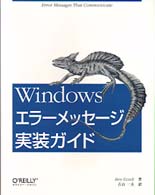- ホーム
- > 洋書
- > 英文書
- > Science / Mathematics
Full Description
Presents the fascinating array of inverse coordination complexes, from monoatomic centres to those with organic molecules as centres, in a systematic manner with colour illustrative examples. This book is a timely and comprehensive introduction to this largely overlooked field of inverse coordination in inorganic chemistry.
Inverse Coordination Chemistry features and discusses the interesting array of inverse coordination complexes, from those with monoatomic or polyatomic centres to those with organic molecules as centres. While traditional coordination complexes consist of a metal atom at the centre surrounded by inorganic ligands, inverse coordination complexes show a reversed topology: a central non-metal atom surrounded by metallic ligands.
Concisely written, this book is a timely and comprehensive introduction to this exciting but largely overlooked field of inverse coordination in inorganic chemistry. This book serves as an invaluable resource for chemists, educators, and students.
Contents
1. INTRODUCTION
1.1 Defining the concept
1.2 Knowing the history
2. MONOATOMIC INVERSE COORDINATION CENTRES
2.1 Triangular complexes
2.1.1 Single-atom bridging linkers
2.1.2 Two-atom bridging linkers
2.1.3 Three-atom bridging linkers
2.2 Tetrahedral complexes
2.2.1 Single-atom bridging linkers
2.2.2 Two-atom bridging linkers
2.2.3 Three-atom bridging linkers
2.3 Planar complexes
2.3.1 Trigonal-bipyramidal and square-pyramidal complexes
2.3.2 Octahedral complexes
2.3.3 Linker-free complexes
3. POLYATOMIC INVERSE COORDINATION CENTRES
3.1 Polynitrogen as the inverse coordination centre
3.1.1 Trinitrogen
3.1.2 Dinitrogen
3.2 Naked phosphorus as the inverse coordination centre
3.2.1 Nonaphosphorus and larger Pn groups
3.2.2 Octaphosphorus groups
3.2.3 Heptaphosphorus groups
3.2.4 Hexaphosphorus groups
3.2.5 Pentaphosphorus groups
3.2.6 Tetraphosphorus groups
3.2.7 Triphosphorus groups
3.2.8 Diphosphorus groups
4. ORGANIC MOLECULES AS INVERSE COORDINATION CENTRES
4.1 Nitrogen heterocycles as inverse coordination centre
4.1.1 Miscellaneous
4.1.2 Bicyclic molecules
4.1.3 Six-membered heterocycles
4.2 Fused-ring systems as inverse coordination centres
4.3 Saturated six-membered rings as inverse coordination centres
4.3.1 Tricyclic species
4.3.2 Bicyclic species
4.3.3 Monocyclic species
4.4 Five-membered rings as inverse coordination centres
4.4.1 Fused five-membered rings
4.4.2 Tetrazole
4.4.3 Triazole
4.4.4 Biimidazole
4.4.5 Imidazole
4.4.6 Pyrazole
4.5 Carboxylates as inverse coordination centres
4.6 Oxocarbons as inverse coordination centres
4.7 Oxalate as an inverse coordination centre, and nitrogen and sulphur analogues
4.8 Organophosphanes as inverse coordination centres
4.9 Thiolates and sulphides as inverse coordination centres
References
Index








